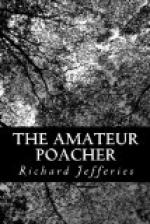Nets were also used for hares and rabbits, which were driven in by a dog; but, the scent of these animals being so good, it was necessary to work in such a manner that the wind might not blow from the net, meeting them as they approached it. Pheasants, as every one knows, roost on trees, but often do not ascend very high; and, indeed, before the leaves are off they are said to be sometimes taken by hand—sliding it along the bough till the legs are grasped, just as you might fowls perched at night on a rail across the beams of a shed.
The spot where they roost is easily found out, because of the peculiar noise they make upon flying up; and with a little precaution the trees may be approached without startling them. Years ago the poacher carried a sulphur match and lit it under the tree, when the fumes, ascending, stupefied the birds, which fell to the ground. The process strongly resembled the way in which old-fashioned folk stifled their bees by placing the hive at night, when the insects were still, over a piece of brown paper dipped in molten brimstone and ignited. The apparently dead bees were afterwards shaken out and buried; but upon moving the earth with a spade some of them would crawl out, even after two or three days.
Sulphur fumes were likewise used for compelling rabbits to bolt from their buries without a ferret. I tried an experiment in a bury once with a mixture the chief component of which was gunpowder, so managed as to burn slowly and give a great smoke. The rabbits did, indeed, just hop out and hop in again; but it is a most clumsy expedient, because the fire must be lit on the windward side, and the rabbits will only come out to leeward. The smoke hangs, and does not penetrate into half the tunnels; or else it blows through quickly, when you must stop half the holes with a spade. It is a wretched substitute for a ferret.
When cock-fighting was common the bellicose inclinations of the cock-pheasants were sometimes excited to their destruction. A gamecock was first armed with the sharp spur made from the best razors, and then put down near where a pheasant-cock had been observed to crow. The pheasant cock is so thoroughly game that he will not allow any rival crowing in his locality, and the two quickly met in battle. Like a keen poniard the game-cock’s spur either slew the pheasant outright or got fixed in the pheasant’s feathers, when he was captured.
A pheasant, too, as he ran deeper into the wood upon an alarm, occasionally found his neck in a noose suspended across his path. For rabbiting, the lurcher was and is the dog of all others. He is as cunning and wily in approaching his game as if he had a cross of feline nature in his character. Other dogs trust to speed; but the lurcher steals on his prey without a sound. He enters into the purpose of his master, and if any one appears in sight remains quietly in the hedge with the rabbit or leveret in his mouth till a sign bids him approach. If half the stories told of the docility and intelligence of the lurcher are true, the poacher needs no other help than one of these dogs for ground game. But the dogs called lurchers nowadays are mostly of degenerate and impure breed; still, even these are capable of a good deal.




